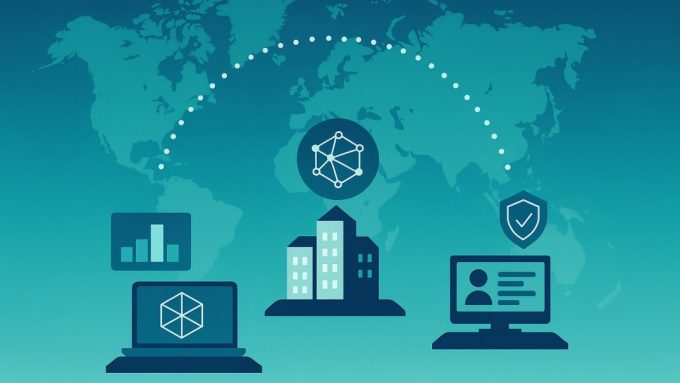By Amr Yafi
Background & Context
In urban centres, demand for energy-efficient and resilient office spaces continues to grow as cities work to
reduce emissions and optimize building operations. Digital twin technology is proving essential in this effort,
providing a platform for more sustainable and responsive building management. PARA OS, a digital twin
solution, recently demonstrated these capabilities in a commercial office building, transforming the building’s
operational performance and sustainability outcomes. This case study examines how PARA OS enabled
streamlined decision-making, resulting in notable improvements in energy efficiency, occupant comfort, asset
reliability, and sustainability
A Building at Crossroads: The Need for Transformation

Figure 1: Cairo Office Building External view
Situated 20 kilometres outside Cairo in the Smart Village high-tech office park, the subject building is a five-story, 47,000-square-meter facility designed to accommodate 2,000 employees, including the company’s Global Executive Leadership. While built with embedded smart technology, the building faced operational challenges commonly seen in advanced facilities: its key systems—HVAC, lighting, and environmental monitoring—were
siloed, limiting cross-functional insight and cohesive management.
In spite of the building’s LEED Gold BD+C certification, management identified several inefficiencies in energy management, occupant comfort, and asset maintenance. Each system operated independently, limiting integration and reducing opportunities for coordinated, data-driven decisions in response to occupancy and operational demands. Studies on similar commercial properties indicate that integrated management of energy, occupancy, and environmental systems can significantly enhance operational effectiveness (Martani, et al., 2012).
Recognizing the need for a cohesive digital strategy, the building’s stakeholders adopted PARA OS’s digital twin platform to enhance facility performance across several targeted outcomes. These objectives include increasing operational efficiency, achieving LEED O+M certification for sustainability, reaching an occupant well-being score of 12/20 in alignment with LEED O+M standards, improving energy intelligence through comprehensive monitoring of energy consumption and energy use intensity, and strengthening asset management. By implementing PARA OS, the building aims to establish a rigorous approach to integrated and sustainable facility management within Cairo’s commercial real estate sector.
Bridging Silos with Technology: The PARA OS Digital Twin Solution
To effectively address the Cairo office building’s core facility management challenges, PARA’s digital twin platform was tailored with four specific modules. Each module was selected to resolve distinct pain points in efficiency, sustainability, and occupant well-being, aligned with the Digital Twin Reference Architecture layers and the Gemini Principles of Purpose, Trust, and Function. Integrating legacy and new systems required meticulous coordination, establishing a unified digital foundation that supports real-time insights, predictive maintenance, and sustainability tracking.

Figure 2: PARA OS System Integration Schematic
Each module was selected to address specific facility management needs:
- Occupant Wellbeing: This module monitors key factors such as temperature, humidity, CO₂, and particulate matter, essential for occupants’ comfort in line with WELL and LEED standards. Studies demonstrate the impact of air quality on productivity (Chegut, et al., 2019), underscoring the importance of this module in maintaining a healthy indoor environment. It aligns with the Gemini Principles of Public Good by enhancing well-being and Value Creation through improved productivity. Additionally, it addresses the Visualization Layer for real-time data access and the Service Layer for setting and monitoring environmental thresholds.
- Energy Intelligence: High energy consumption was identified as a critical issue, particularly evident during COVID-19 when occupancy levels dropped but energy usage remained disproportionately high, highlighted the need for optimization This module provides real-time insights into energy demand by zone and utility type (e.g., HVAC, lighting), using machine learning to dynamically adjust targets, peak loads and setpoints based on occupancy patterns. Studies show that such dynamic controls can reduce consumption by up to 17% (Lee, et al., 2016). The module addresses the Gemini Principles of Value Creation and Insight through efficient energy management, and is inline with the Analytics Layer enabling data-driven adjustments and the Control Layer automating energy use based on occupancy patterns.
- Asset Management: Ensuring asset reliability and longevity is critical for the office building facility management team. PARA OS’s Asset Management module, equipped with Fault Detection and Diagnostics (FDD), proactively monitors asset performance, providing alerts to prevent downtime and enabling maintenance based on real-time data. This approach aligns with findings that digital twins reduce operational costs by facilitating proactive asset management (Moretti, et al., 2022). This approach aligns with the Gemini Principles of Quality, by reducing operational risks, and Openness, by providing transparent data on asset status. Relevant layers include the Data Management & Integration Layer for consolidated asset data and the Analytics Layer for predictive maintenance.
- Sustainability Management: Aligned with the building’s sustainability targets, this module tracks carbon emissions, renewable energy use, and adherence to green standards such as LEED. Research indicates that integrating renewable energy management within digital twins can achieve a 15% reduction in energy use (Agostinelli, et al., 2022). Given growing ESG requirements, it addresses the Gemini Principle of Public Good by enhancing environmental accountability and supports Federation by unifying sustainability metrics. Relevant layers include the Modelling & Simulation Layer for forecasting sustainability outcomes and the Data Management & Integration Layer for real-time environmental monitoring.
PARA OS primarily operates within the Data Management & Integration Layer of the Digital Twin Reference Architecture, creating a unified data foundation across systems, with the Analytics Layer converting raw data into actionable insights, particularly within the Energy Intelligence and Asset Management modules. Security protocols—including Data Protection, Encryption, Access Control, and Authorization Levels—align with the Trust principles of the Gemini framework, addressing standards, IP rights, and ownership. Overall, PARA OS enables a proactive approach to facility management, establishing a benchmark for sustainable, data-driven operations that adhere to both the Gemini Principles and the Digital Twin Reference Architecture.
A New Standard for Efficiency and Sustainability

Figure 3: PARA OS selected Modules to meet the office building stakeholders’ objectives
PARA OS’s deployment led to transformative results in operational efficiency and sustainability for the Cairo
office building:
- Occupant Wellbeing: Improved air quality, temperature, and humidity levels achieved a LEED O+M comfort score of 16/20, with studies suggesting that similar improvements in air quality and occupant wellbeing could lead to a 10%-20% increase in employee productivity (Moretti, et al., 2022).
- Energy Intelligence: Real-time occupancy-based control settings reduced total energy consumption by 28%, lowering costs and aligning with global sustainability goals. Research from Stanford’s Centre for Integrated Facility Engineering indicates that digital twins can cut non-budgeted change orders, achieving up to 40% budget reliability (Gao & Fischer, 2008).
- Asset Management: PARA OS’s fault detection capabilities minimized downtime, improving operational efficiency by 20% through predictive maintenance, aligning with findings by (Lu, et al., 2022) on the effectiveness of digital twins in proactive asset management.
- Sustainability Management: The building reached LEED O+M Gold certification, with PARA OS’s sustainability module enabling precise monitoring of environmental parameters and green building compliance. This accomplishment supported the building’s commitment to environmental stewardship, enhancing its appeal to eco-conscious stakeholders.
By consolidating disparate systems into a single, data-driven platform, PARA OS successfully transformed the Cairo building’s operational approach from reactive to proactive management, demonstrating the tangible benefits of digital twin technology in the commercial real estate sector.
Conclusion: Digital Twins as the Future of Urban Building Management
This case study of PARA OS’s digital twin deployment in a Cairo office building illustrates the transformative impact of integrated technology on operational efficiency and sustainability. By unifying diverse systems within a centralized platform, PARA OS enabled precise monitoring, maintenance, and optimization, resulting in significant reductions in energy consumption, improved air quality, enhanced asset reliability, and strengthened sustainability. Classified as a Technology Readiness Level (TRL) 7 solution—a standard developed by NASA to evaluate the maturity of emerging technologies (Manning,
2023)—PARA OS has reached this level because it has been successfully demonstrated in relevant operational environments, validating its effectiveness in complex facility management scenarios.
As the real estate sector continues to evolve, PARA OS’s success in Cairo offers a scalable model for maximizing the potential of commercial buildings. Digital twins are not merely standalone solutions; they are essential tools for creating resilient, sustainable environments that enhance occupant experiences and support critical environmental goals.
Watch the Gemini Call Presentation
Want to see how these insights were originally shared with the Digital Twin Hub community? Watch my Gemini Call presentation where Amr Yafi delivered his presentation:
Call for Speakers: Share your Digital Twin story in 2025
We’re actively seeking presenters who can contribute to our community’s knowledge and understanding of Digital Twins. Whether you’re working on groundbreaking projects, conducting research, or have valuable lessons learned to share, we want to hear from you.
Ready to share your expertise? Complete our quick 10-minute speaker proposal form:
Join the community in advancing the conversation around Digital Twins and their transformative potential across industries.
Leave a comment
You must be logged in to post a comment.


Thank you for sharing this excellent case study with the DT Hub community, Amr.
thanx for that, its helpful